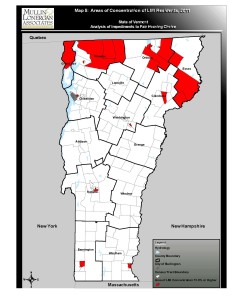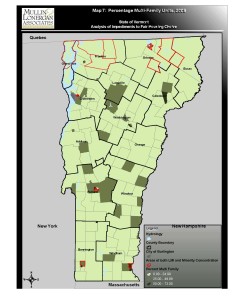When housing advocates talk about increasing the stock of affordable housing, they’re typically referring to multi-family rental housing. Not that programs to expand home-ownership for lower income people aren’t important — they are. But it’s generally agreed that the most cost-effective way to alleviate the affordable housing shortage is by developing multi-family complexes.
Vermont is a rural state, of course, and multi-family housing tends to be concentrated in urban and semi-urban areas, such as Chittenden County. Nevertheless, it makes sense to think about other parts of the state where there’s a clear but unfilled need for multifamily housing.
Consider these two maps from the 2012 Analysis of Impediments to Fair Housing Choice, which the state Department of Housing and Community Development filed with the U.S. Department of Housing and Urban Development.
The first map shows 14 census tracts identified as areas where low and moderate income persons (LMI) are concentrated:
The second map shows where multi-family housing is located, as a percentage of all housing. This map also outlines the LMI areas:
So, which counties with concentrations of lower- and middle-income people are short on multi-family housing, and which counties could clearly accommodate more multi-family housing than they have?
Grand Isle, Franklin, Orleans and Caledonia.



